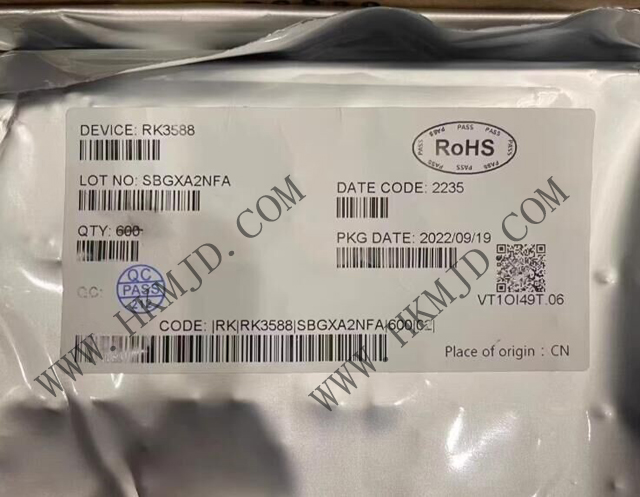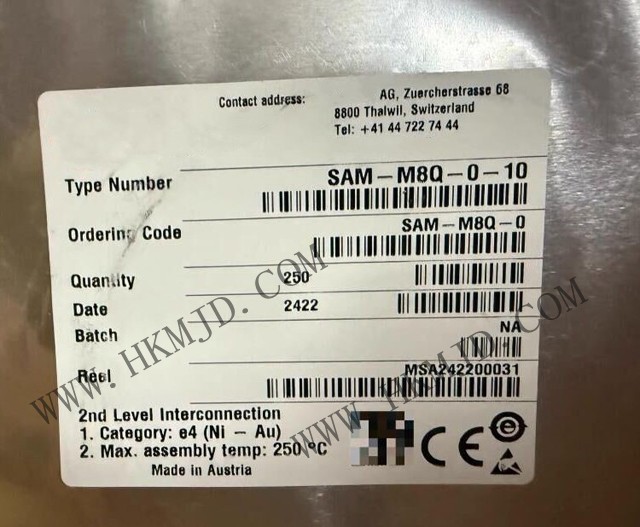Welcome Here Shenzhen Mingjiada Electronics Co., Ltd.

sales@hkmjd.com

sales@hkmjd.com

Service Telephone:86-755-83294757
 Latest Information
Latest InformationST STM32F091VCH6 32-Bit Mainstream ARM Cortex-M0 Access Line MCUAs a professional distributor in the field of electronic components, Shenzhen Mingjiada Electronics Co., Ltd. has been supplying ST STM32F091VCH6 mainstream MCU based on ARM Cortex-M0 cor…
ST STM32F091VCH6 32-Bit Mainstream ARM Cortex-M0 Access Line MCU
As a professional distributor in the field of electronic components, Shenzhen Mingjiada Electronics Co., Ltd. has been supplying ST STM32F091VCH6 mainstream MCU based on ARM Cortex-M0 core for a long time, which is a 32-bit microcontroller with its high performance, rich peripherals and low-power consumption, and has shown a wide range of application potentials in the fields of industrial control, consumer electronics, and Internet of Things.
Product Overview and Core Architecture
STM32F091VCH6 is ST's mainstream 32-bit microcontroller, belonging to the STM32F0 series product line of high-performance chips, which occupies an important position in embedded system design due to its balanced performance configuration and cost-effectiveness.
In terms of core architecture, the STM32F091VCH6 is equipped with a 48MHz ARM Cortex-M0 processor core. This architecture, although belonging to ARM's entry-level design, has been optimised by ST to provide excellent efficiency of 0.95 DMIPS/MHz. The processor adopts a three-stage pipeline design and supports the Thumb-2 instruction set, providing performance close to the Cortex-M3 level while maintaining the code density advantage. Of particular note, the core integrates a Nested Vector Interrupt Controller (NVIC) that manages up to 32 programmable priority interrupt sources, providing reliable response guarantees for real-time applications.
In terms of memory configuration, the STM32F091VCH6 provides 256KB of Flash memory and 32KB of SRAM, a combination of capacities that enables it to handle relatively complex control algorithms and multitasking applications.The Flash memory supports read-acceleration, which enables zero-wait state access and ensures code execution efficiency at the full speed of 48 MHz. SRAM is equipped with a hardware parity function, which enhances the reliability of the system in harsh electromagnetic environments. In addition, the STM32F091VCH6 provides a dedicated 8KB SRAM area that can be used for communication stacks or specific data buffering needs.
In terms of package and pinout, the STM32F091VCH6 is available in an LQFP100 package and provides up to 87 GPIO (general purpose input/output) pins, most of which are multiplexed and can be flexibly configured as interfaces for various peripherals. With a package size of 14x14mm, the STM32F091VCH6 chip is suitable for embedded applications with more relaxed space requirements.The STM32F091VCH6 chip's operating temperature range covers the industrial standard of -40°C to +85°C, and it can also support extended industrial temperature range of -40°C to +105°C.
Peripheral Interfaces and Features
The STM32F091VCH6 microcontroller is known for its rich configuration of peripheral interfaces, which can meet the diverse needs of complex embedded systems.
For communication interfaces, the STM32F091VCH6 integrates up to 8 USART interfaces supporting synchronous/asynchronous communication, LIN master-slave mode, IrDA infrared encoding and decoding, and smart card mode. Three of the USART interfaces support the ISO7816 protocol for direct connection to smart card readers. In addition, the STM32F091VCH6 is equipped with 2 SPI interfaces (18Mbit/s) and 2 I2C interfaces (supporting Fast Mode Plus 1Mbit/s), providing a flexible connectivity solution for sensor networks, display modules and other peripherals. Of particular note, the STM32F091VCH6 includes a CAN 2.0B active controller that supports communication rates up to 1Mbit/s, enabling easy integration into industrial automation, automotive electronics, and other application scenarios that require CAN bus communication.
The analogue function module is another highlight of the STM32F091VCH6. The chip has a built-in 12-bit ADC converter with 16 external channels and three internal channels (temperature sensor, internal reference voltage and VBAT monitoring), a conversion rate of 1MSPS and support for hardware oversampling, which can increase the effective resolution to 16 bits. The STM32F091VCH6 microcontroller also integrates two 12-bit DAC channels that support a variety of trigger modes and waveform generation functions to directly drive analogue loads or generate control signals. Together with programmable gain amplifiers (PGAs) and comparators, these analogue peripherals form a complete signal chain solution for a wide range of sensing and control systems.
For the timing and control subsystem, the STM32F091VCH6 provides seven 16-bit timers and one 32-bit timer, including:
1 advanced control timer (TIM1) supporting 6 PWM outputs and dead time insertion, suitable for motor control applications
1 general-purpose timer (TIM2) with 32-bit counting capability
5 general-purpose timers (TIM3/TIM14/TIM15/TIM16/TIM17)
1 independent watchdog timer and 1 window watchdog timer to enhance system reliability
1 24-bit SysTick timer for operating system beats or precision delays
The clock system design reflects the flexibility of the STM32F091VCH6. The chip supports a 4-32MHz external crystal oscillator and an internal 16MHz/48MHz RC oscillator, with a built-in PLL for clock multiplication. In addition, a 32kHz low-speed external crystal oscillator (LSE) and an internal low-speed RC oscillator (LSI) are integrated to provide clock sources for real-time clock (RTC) and low-power modes. This multi-clock source design ensures performance requirements while meeting low-power application scenarios.
Power management and low-power features
The STM32F091VCH6 excels in power management. Designed with an advanced power architecture, the microcontroller supports a wide voltage supply range of 2.0V to 3.6V, which can be powered directly by a Li-ion battery or used with various regulated power supplies.
The STM32F091VCH6 provides a variety of low-power modes that can be flexibly selected to optimise system power consumption according to application requirements:
Sleep mode: only the CPU stops working, peripherals keep running, and the wake-up time is very short.
Stop mode: SRAM and registers are preserved, the main clock is switched off, the 1.8V domain is powered down, and the typical current consumption is only 10μA.
Standby mode: lowest power state, only the backup domain and optional RTC remain powered, current consumption as low as 2μA
VBAT mode: powered by battery via dedicated pin, only RTC and backup registers are maintained
Dynamic voltage regulation is another energy-saving feature of the STM32F091VCH6. The chip has a built-in programmable voltage regulator (PWR) that dynamically adjusts the kernel voltage according to the CPU operating frequency, ensuring performance while minimising power consumption. For example, when the CPU is running at full speed at 48MHz, the regulator provides 1.8V core voltage; while at lower frequencies, the voltage can be automatically reduced to 1.5V or 1.2V, significantly reducing dynamic power consumption.
For power monitoring, the STM32F091VCH6 integrates a power-on reset (POR)/power-down reset (PDR) circuit, a programmable voltage detector (PVD), and a low-power BOR (brown-out reset) function. These features ensure reliable operation of the system during power fluctuations or low battery power, making it particularly suitable for portable and battery-powered devices. It is worth mentioning that the STM32F091VCH6 also supports wake-up from Stop mode via an external interrupt or specific event with a wake-up time of less than 5μs, achieving a perfect balance between fast response and low power consumption.
Application Scenarios
With its balanced performance configuration and rich peripheral resources, the STM32F091VCH6 demonstrates a wide range of application potentials in multiple industry sectors.
The industrial control field is a typical application scenario for this microcontroller. Its CAN interface and multiplexed USART make it ideal for PLCs (Programmable Logic Controllers), and industrial robot control units. In these applications, the STM32F091VCH6 can simultaneously handle fieldbus communication, multi-axis motor control (via advanced timer PWM outputs), and various sensor signal acquisitions (via 12-bit ADCs). For example, in automated production lines, the chip is able to monitor parameters such as temperature and pressure in real time and communicate with a host computer via CAN bus for closed-loop control.
Consumer electronics applications also benefit from the STM32F091VCH6's feature set. In smart home devices, the microcontroller enables LED dimming and motor speed regulation (e.g., smart fans) via PWM, connects to environmental sensors using an I2C interface, and drives a TFT display via SPI. Its low-power characteristics are particularly suitable for wireless remote control, intelligent door locks and other battery-powered devices, standby current as low as microamps can significantly extend the product life time.
Communication devices are another important application direction. the multi-protocol support of the STM32F091VCH6 enables it to build gateway devices for serial to WiFi/Bluetooth communication. 8 USART interfaces allow simultaneous connection of multiple Modbus RTU devices, and data integrity is ensured by the inbuilt CRC calculation unit. In IoT edge nodes, the chip can undertake data acquisition, protocol conversion and local processing tasks, reducing the burden on the cloud.
The medical electronics field has a special need for the STM32F091VCH6's high-precision ADC and hardware calibration function. The chip can be integrated into portable medical devices such as glucose meters and blood pressure monitors to accurately measure bioelectrical signals and sensor data, and the hardware parity function of the SRAM ensures the reliability of critical medical data and meets the safety standards of relevant medical devices.

Time:2025-07-18
![[Supply] AD8139ARDZ (ADI) Low Noise, High Performance Differential Amplifier](/upload/202507/18/202507181558494187.jpg)
Time:2025-07-18

Time:2025-07-18

Time:2025-07-18
Contact Number:86-755-83294757
Enterprise QQ:1668527835/ 2850151598/ 2850151584/ 2850151585
Business Hours:9:00-18:00
E-mail:sales@hkmjd.com
Company Address:Room1239, Guoli building, Zhenzhong Road, Futian District, Shenzhen, Guangdong
CopyRight ©2022 Copyright belongs to Mingjiada Yue ICP Bei No. 05062024-12

Official QR Code
Links: